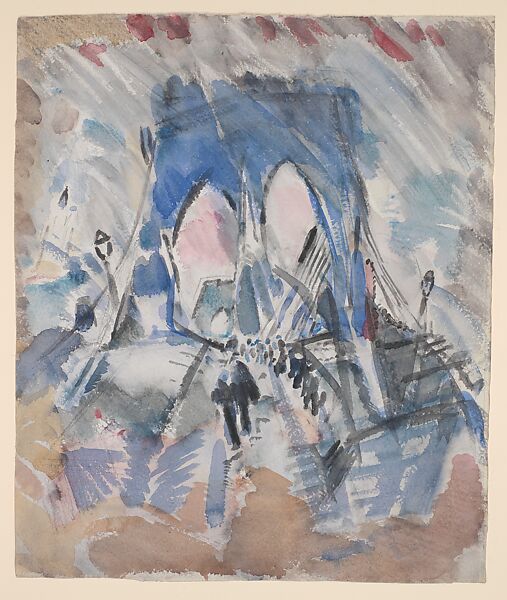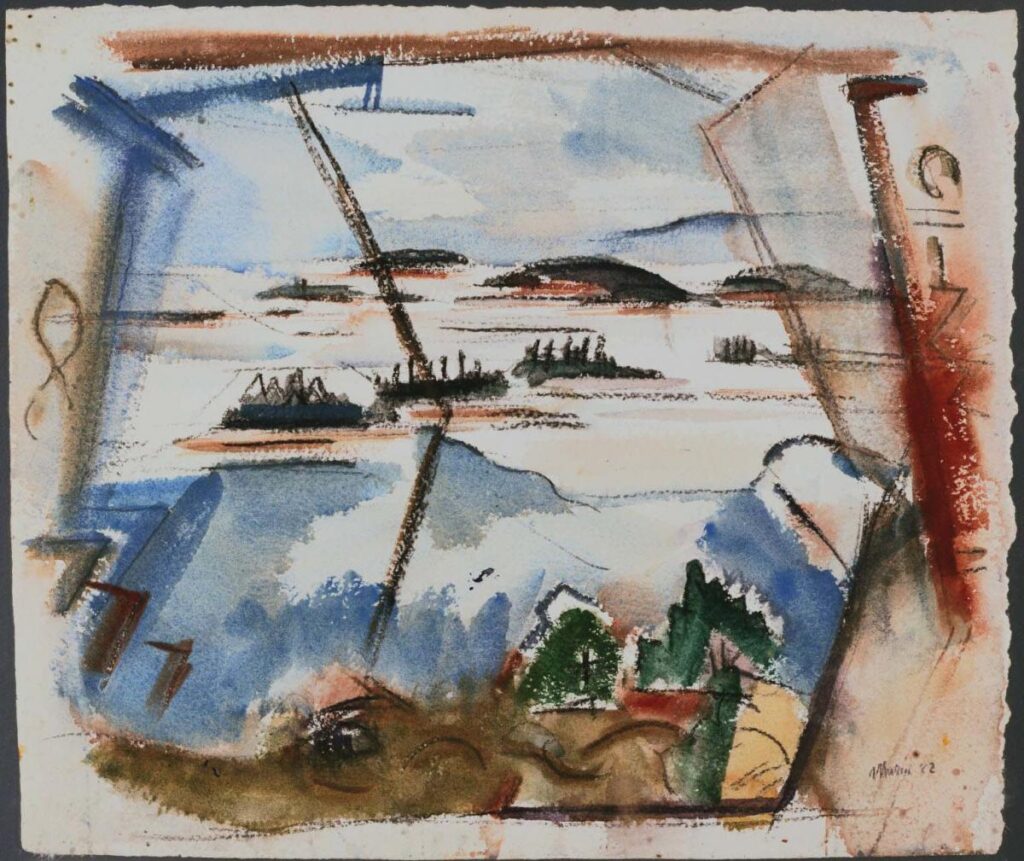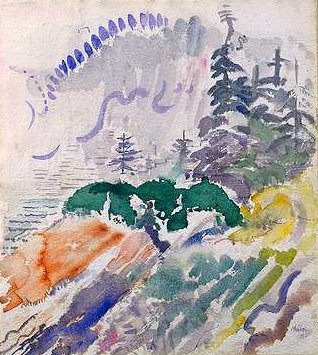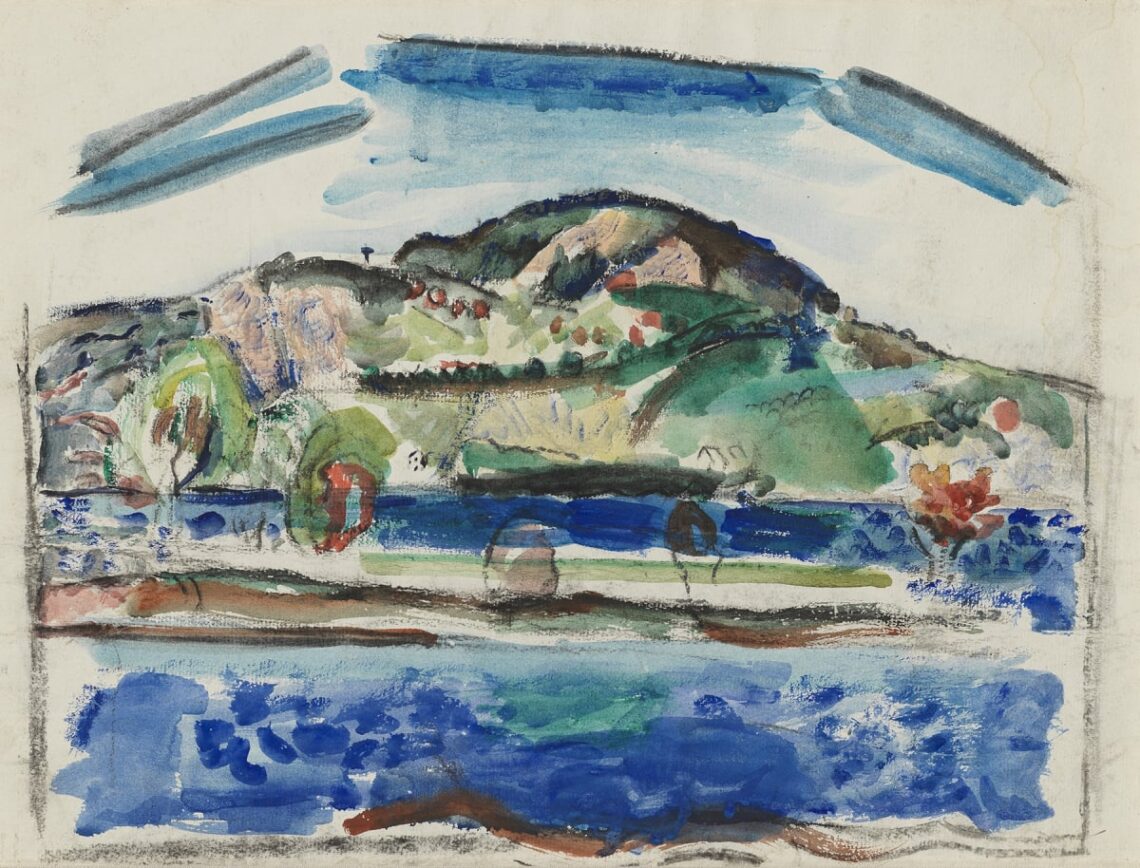In the kaleidoscope of American modernist art, one name stands out with a vibrancy that continues to captivate audiences – John Marin. Born in 1870 in Rutherford, New Jersey, Marin’s artistic journey traversed the realms of the ordinary to the extraordinary. His early education at the Pennsylvania Academy of the Fine Arts set the stage for an artistic odyssey that would see him crossing the Atlantic to absorb the avant-garde movements of Europe. However, it was the sizzling summers in Maine that would become the crucible for Marin’s creativity, igniting a passion for abstraction that would redefine the possibilities of modern art. Marin, a master of both watercolor and oil, carved an illustrious career, leaving behind a legacy of John Marin paintings that continue to echo through the corridors of art history.
Now, let’s embark on a visual exploration of the kaleidoscopic world Marin painted, where each canvas is a testament to his innovation, passion, and unwavering commitment to pushing the boundaries of artistic expression.
1. Brooklyn Bridge

| Date | 1912 |
| Dimension | 45.7 x 35.6 cm |
| Location | The Met, New York |
“Brooklyn Bridge” is Marin’s love letter to the city that never sleeps. Imagine the bridge doing the cha-cha with the skyline, and you’re almost there! The year is 1912; Marin, armed with his palette, dives into the urban jungle, capturing the essence of the iconic bridge with a rhythm that would make even the coolest jazz cats jealous. The canvas comes alive with the pulsating energy of the city, each stroke of Marin’s brush a note in the symphony of modern life.
2. St. Paul’s, Manhattan

| Date | 1912 |
| Dimension | 35.6 x 27.9 cm |
| Location | Whitney Museum of American Art, New York |
“St. Paul’s, Manhattan” is like the city’s secret diary. Marin spills the beans on the timeless beauty of St. Paul’s Chapel, giving it a touch of whimsy and a dash of mystery. This 1912 masterpiece is a visual time capsule, a snapshot of Manhattan that transcends time. The angular strokes and vibrant hues create a dynamic visual narrative, inviting viewers to step into Marin’s world, where architecture becomes a character in a captivating story.
3. Tunk Mountains, Autumn, Maine

| Date | 1929 |
| Dimension | 55.9 x 71.1 cm |
| Location | The Met, New York |
Hold onto your hats, folks! “Tunk Mountains, Autumn, Maine” takes us on a psychedelic journey through the fall foliage. It’s like Marin handed Mother Nature a paintbrush and said, “Go crazy!” Fast forward to 1929, and Marin, now a seasoned painter, immerses himself in the picturesque landscapes of Maine. The canvas explodes with the fiery reds and golden yellows of autumn, capturing the essence of nature’s grand finale before winter takes the stage.
4. Off York Island

| Date | 1926 |
| Dimension | 73 x 92.7 cm |
| Location | Museum of Modern Art, New York |
“Off York Island” is the visual equivalent of a wave crashing against the rocks. Marin captures the essence of the sea in a dance of colors that’ll make you want to grab a surfboard and ride the artistic wave. Transport yourself to 1926, where Marin, ever the explorer, sets sail into the world of marine beauty. The canvas becomes a stage for the drama of crashing waves, with each stroke a splash of sea spray frozen in time.
5. Weehawken Sequence

| Date | 1916-1917 |
| Dimension | Various sizes |
| Location | Private collections |
The “Weehawken Sequence” is like a flipbook of Marin’s love affair with this location. It’s a series that tells a story, like a Netflix binge for art lovers. Step into the time machine, dear art aficionados, as we revisit 1916-1917, a period when Marin was on a Weehawken odyssey. The sequence is a dynamic collection of various sizes and perspectives, a visual diary capturing Marin’s evolving relationship with this particular corner of the world. It’s a journey through the eyes of an artist, a series of snapshots that unfold like a captivating novel.
6. Mt. Chocorua No. 1

| Date | 1920 |
| Dimension | 91.4 x 71.1 cm |
| Location | National Gallery of Art, Washington, D.C. |
“Mt. Chocorua No. 1” is Marin’s mountain symphony. With bold strokes, he conducts nature’s orchestra, and the result is a visual crescendo that’ll leave you breathless. Fast forward to 1920, and Marin is donning his explorer’s hat again, this time navigating the majestic White Mountains of New Hampshire. The canvas becomes a stage for a symphony of colors, with Mt. Chocorua taking center stage. The artist’s dynamic brushstrokes create a visual harmony, echoing the grandeur of the natural world.
7. Top of Radio City, New York City

| Date | 1929 |
| Dimension | 55.9 x 71.1 cm |
| Location | Crystal Bridges Museum of American Art, Arkansas |
“Top of Radio City” is Marin’s backstage pass to the city skyline. It’s like he climbed to the top, hung out with the clouds, and painted the view. Talk about a VIP experience! Jump to 1929, and Marin is on a skyscraper escapade. The canvas transforms into a bird’s-eye view of the city, with Radio City taking center stage. It’s a visual extravaganza where the city lights become stars, and Marin is the director orchestrating a dazzling spectacle.
8. Weehawken Sequence, No. 30

| Date | 1916-1917 |
| Dimension | Various sizes |
| Location | Private collections |
The thirtieth installment in the Weehawken saga! It’s like Marin’s own reality show – each episode (or painting) revealing a new twist in the tale. Drama, intrigue, and lots of color! Imagine yourself in the roaring twenties, where Marin is deep into his Weehawken exploration. No. 30 in the sequence is a revelation, a plot twist in the narrative that keeps us hooked. Each brushstroke is a cliffhanger, urging us to dive deeper into Marin’s artistic saga.
9. Island (Ship’s Stern)

| Date | 1922 |
| Dimension | 50.8 x 61 cm |
| Location | Addison Gallery of American Art, Massachusetts |
“Island (Ship’s Stern)” is the hidden gem in Marin’s treasure trove. Who knew a ship’s stern could look so darn cool? It’s like finding a funky accessory that ties the whole outfit together. Flashback to 1922, and Marin’s artistic eye catches the allure of a ship’s stern. The canvas becomes a playground for experimentation, a place where unexpected elements take center stage. The result? A hidden gem that showcases Marin’s skill to find beauty in the most unexpected places.
10. Sunset

| Date | 1914 |
| Dimension | 55.9 x 71.1 cm |
| Location | The Met, New York |
“Sunset” is Marin’s way of saying, “Hey, nature, you’re beautiful!” Imagine the sun giving the sky a high-five before calling it a day. Pure magic! Step into 1914, where Marin is capturing the fleeting beauty of dusk. The canvas transforms into a dreamscape, a place where the sun and sky engage in a cosmic high-five. It’s a moment frozen in time, a celebration of the natural world’s daily grand finale.
11. Marin Island

| Date | 1914 |
| Dimension | 45.7 x 35.6 cm |
| Location | Whitney Museum of American Art, New York |
“Marin Island” is the cool older sibling of the bunch. It’s Marin’s later work, and you can feel the wisdom in every stroke. It’s like the Mona Lisa’s rebellious cousin. Fast forward to 1914, where Marin’s artistic journey has evolved. “Marin Island” reflects a more mature and nuanced approach. The canvas becomes a canvas of introspection, a place where every stroke tells a story of artistic evolution. It’s the cool older sibling, the rebel with a cause in Marin’s body of work.
12. Autumn Coloring No. 4

| Date | 1950 |
| Dimension | 78.7 x 104.1 cm |
| Location | The Met, New York |
“Autumn Coloring No. 4” is the grand finale, the fireworks at the end of the Marin extravaganza. It’s Marin saying, “I’ve been doing this for decades, and I’m still rocking it!” Fast forward to 1950, and Marin, like a seasoned rockstar, takes center stage with “Autumn Coloring No. 4.” The canvas becomes a celebration, a visual explosion of colors that marks the culmination of a lifelong artistic journey. It’s Marin’s way of saying, “Cheers to decades of creativity, and I’m still rocking the art scene!”
Frequently Asked Questions
Why was John Marin famous?
John Marin was one of the first modernist artists in America. His paintings and abstract landscapes are well-known.
What is John Marin’s watercolor technique?
Marin became a prominent character in American modern art because of his spontaneous use of color, paint application, perspective, and movement.
Conclusion
So there you have it – an extended glimpse into the groovy world of John Marin paintings. His paintings aren’t just canvases with colors; they’re visual symphonies, dance parties, and nature’s high-fives. As you wander through the art gallery of life, channel your inner Marin, let loose, and boogie through the brushstrokes!













